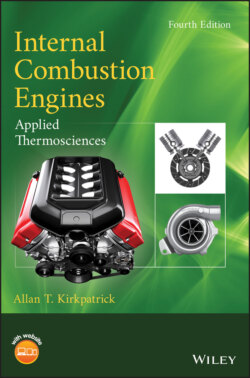Читать книгу Internal Combustion Engines - Allan T. Kirkpatrick - Страница 56
Exhaust Stroke
ОглавлениеThe exhaust stroke has two processes: gas blowdown and gas displacement. At the end of the expansion stroke 3 to 4, the pressure in the cylinder is greater than the exhaust pressure. Hence, when the exhaust valve opens, gas will flow out of the cylinder even if the piston does not move. Typically the pressure ratio, , is large enough to produce sonic flow at the valve so that the pressure in the cylinder rapidly drops to the exhaust manifold pressure, , and the constant volume approximation is justified. The remaining gas in the cylinder that has not flowed out through the exhaust valve undergoes an expansion process. If heat transfer is neglected, this unsteady expansion process can be modeled as isentropic. Note that both the closed valve expansion from 3 to 4 and the open valve expansion from 4 to 5 are modeled as isentropic processes.
Therefore, the temperature and pressure of the exhaust gases remaining in the cylinder are
(2.38)
(2.39)
As the piston moves upward from bottom dead center, it pushes the remaining cylinder gases out of the cylinder. The cylinder pressure is assumed to remain constant at . Since internal combustion engines have a clearance volume, not all of the gases will be pushed out. There will be exhaust gas left in the clearance volume, called residual gas. This gas will mix with the incoming air or fuel–air mixture, depending on the location of the fuel injectors.
The state of the gas remaining in the cylinder during the exhaust stroke can be found by applying the closed‐system first law to the cylinder gas from state 5 to state 6 as shown in Figure 2.11. The closed‐system control volume will change in shape as the cylinder gases flow out the exhaust port across the exhaust valve. Note that while the blowdown is assumed to occur at constant cylinder volume, the control mass is assumed to expand isentropically.
Figure 2.11 The exhaust stroke (4 to 5 to 6) illustrating residual mass.
The energy equation is
(2.40)
The work term is
(2.41)
and if the flow is assumed to be adiabatic, the first law becomes
(2.42)
or
(2.43)
(2.44)
Therefore, during an adiabatic exhaust stroke, the enthalpy and temperature of the exhaust gases remain constant as they leave the cylinder, and the enthalpy of the residual gas left in the cylinder clearance volume is constant. The residual gas fraction, , is the ratio of the residual gas mass, , in the cylinder at the end of the exhaust stroke (state 6) to the mass, , of the fuel–air mixture:
(2.45)
Since
(2.46)
the residual fraction is
(2.47)
With a compression ratio of 9, 101 kPa, 500 kPa, and 1.3, the residual fraction 0.035. Since heat transfer to the cylinder walls is neglected in this analysis, this analysis will underpredict the actual residual fraction. Typical values of the residual gas fraction, , are in the 0.03 to 0.12 range. The residual gas fraction is lower in Diesel cycle engines than in Otto cycle engines, due to the higher compression ratio in Diesel cycles.
